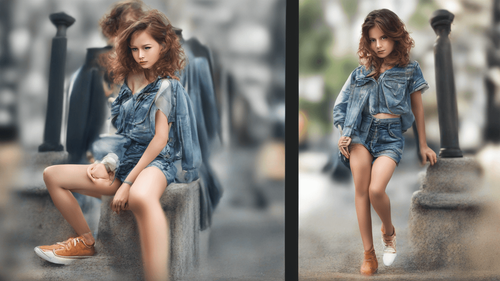
Introduction
In the ever-evolving world of digital art and design, the process of transforming photos into vector illustrations has become an indispensable skill for graphic artists, illustrators, and designers. This technique not only enhances the visual appeal of images but also opens up a realm of creative possibilities. Welcome to a comprehensive guide on mastering the art of photo to vector illustration, exploring various techniques, tools, and benefits.
Photo to Vector Illustration: Unveiling the Magic
Vector illustration is a technique that uses mathematical equations to create images composed of paths, shapes, and lines, unlike raster images made of pixels. The process of converting a photo into a vector illustration involves tracing and recreating the image using vector shapes. This method preserves image quality and scalability, making it a favored choice in logo design, icon creation, and more.
The Power of Photo to Vector Illustration
Vectorization not only breathes new life into images but also offers a plethora of benefits:
Enhanced Scalability and Quality
Vector images can be scaled to any size without losing quality. This scalability makes them suitable for various applications, from business cards to billboards.
Crisp Edges and Clean Lines
Unlike raster images, vectors boast crisp edges and clean lines, lending a professional and polished look to the final artwork.
Versatility in Design
Vectorization provides the flexibility to experiment with different colors, gradients, and effects, allowing designers to create visually striking and captivating illustrations.
Simplified Editing
Vector illustrations are composed of individual elements that can be easily manipulated, allowing for quick and efficient edits.
Techniques for Photo to Vector Illustration
Mastering the art of transforming photos into vector illustrations requires a solid understanding of various techniques:
Tracing with Pen Tool: Precision at Your Fingertips
The pen tool is a staple in vectorization, allowing artists to manually trace the contours of an image. This technique offers unparalleled precision and control over the final outcome.
Automatic Vectorization: Balancing Speed and Accuracy
Automatic vectorization tools, such as Adobe Illustrator's "Image Trace," offer a quicker solution by converting photos into vector paths. While convenient, these tools may require manual adjustments for optimal results.
Layering and Shape Building: Constructing Complexity
Layering and shape-building techniques involve creating individual vector shapes and arranging them to recreate the photo's details. This approach is particularly useful for intricate designs.
Essential Tools for Photo to Vector Illustration
Equipping yourself with the right tools can make the vectorization process smoother and more efficient:
Adobe Illustrator: The Industry Standard
Adobe Illustrator remains the go-to software for vector illustration. Its robust pen tool, anchor point manipulation, and pathfinder options provide a comprehensive toolkit for artists.
CorelDRAW: A Competitor Worth Considering
CorelDRAW offers a user-friendly interface and a range of vectorization tools. Its "PowerTRACE" feature simplifies the conversion process while maintaining control over key parameters.
Inkscape: Open-Source Excellence
Inkscape, an open-source alternative, provides an array of vectorization tools. While it may lack some advanced features, it's a great option for beginners and those on a budget.
Best Practices for Flawless Vectorization
Achieving optimal results in photo to vector illustration requires adherence to certain best practices:
Choose the Right Image
Start with a high-resolution image to ensure clarity and accuracy during vectorization. Images with distinct contrast between subjects and backgrounds yield better results.
Begin with Basic Shapes
When vectorizing, start with basic shapes before adding intricate details. This approach helps establish the foundation of the illustration.
Utilize Layers for Organization
Organize your vector elements into layers, making it easier to manage and edit different parts of the illustration.
Be Mindful of Anchor Points
Anchor points are essential in vectorization. Use them sparingly and strategically to maintain smooth curves and lines.
FAQs
How long does it take to master photo to vector illustration?
Mastering vectorization varies based on individual learning pace and dedication. With consistent practice, one can achieve proficiency in a few months.
Is photo to vector conversion suitable for all types of images?
While vectorization works well for most images, intricate and heavily detailed photographs may require manual adjustments for optimal results.
Can I vectorize a hand-drawn sketch?
Yes, you can scan or photograph a hand-drawn sketch and vectorize it using the outlined techniques.
Are there any copyright concerns when vectorizing photos?
When vectorizing photos, ensure you have the right to use the original image, especially if it's copyrighted material.
What file formats are commonly used for vector illustrations?
Vector illustrations are often saved in formats such as AI (Adobe Illustrator), SVG (Scalable Vector Graphics), and PDF (Portable Document Format).
Can I edit a vector illustration after it's created?
Yes, one of the significant advantages of vector illustrations is their editability. You can revisit and make changes to the illustration at any time.
Conclusion
Embarking on the journey of mastering photo to vector illustration opens up a world of creativity and artistic expression. Whether you're a professional designer or an aspiring artist, the techniques and tools explored in this guide empower you to transform ordinary photos into captivating vector illustrations. Embrace the precision, versatility, and limitless possibilities of vector artistry, and unveil your potential as a photo to vector illustrator.